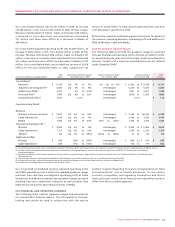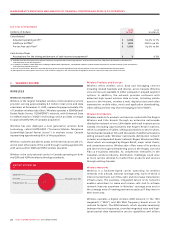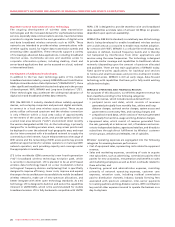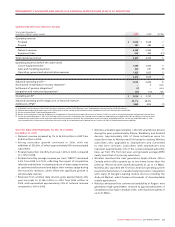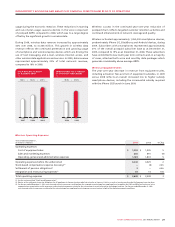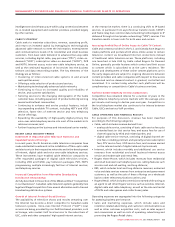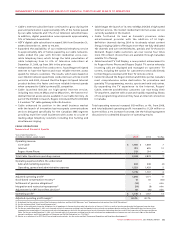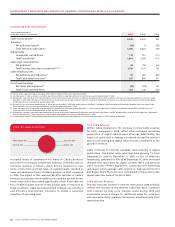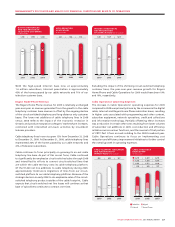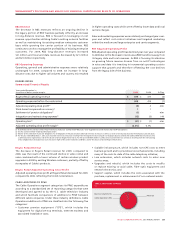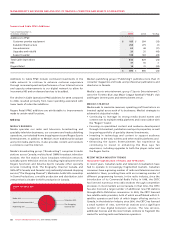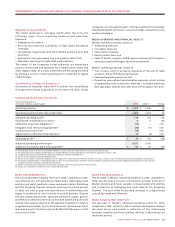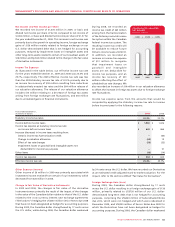Rogers 2009 Annual Report Download - page 29
Download and view the complete annual report
Please find page 29 of the 2009 Rogers annual report below. You can navigate through the pages in the report by either clicking on the pages listed below, or by using the keyword search tool below to find specific information within the annual report.
ROGERS COMMUNICATIONS INC. 2009 ANNUAL REPORT 33
MANAGEMENT’S DISCUSSION AND ANALYSIS OF FINANCIAL CONDITION AND RESULTS OF OPERATIONS
intelligent services infrastructure while using connections between
its co-located equipment and customer premises, provided largely
by other carriers.
CABLE’S STRATEGY
Cable seeks to maximize subscribers, revenue, operating profit,
and return on invested capital by leveraging its technologically
advanced cable network to meet the information, entertainment
and communications needs of its residential and small business
customers, from basic cable television to advanced two-way cable
services, including digital cable, pay-per-view (“PPV”), video-on-
demand (“VOD”), subscription video-on-demand (“SVOD”), PVR
and HDTV, Internet access, voice-over-cable telephony service, as
well as the continued expansion of its services into the business
telecom and data networking market. The key elements of the
strategy are as follows:
• Clustering of interconnected cable systems in and around
metropolitan areas;
• Offeringawideselectionofproductsandservices;
• Maintainingtechnologicallyadvancedcablenetworks;
• Continuing to focus on increased quality and reliability of
service, and customer satisfaction;
• Tailoring services to the changing demographic of the Cable
customer base, including expansion of products directly serving
several multicultural communities;
• Continuing to enhance and evolve product features, includ-
ing expanding available TV content, including HDTV and VOD
selection, faster tiers of Internet service and new telephony
service offerings;
• Expandingtheavailabilityofhigh-qualitydigital primaryline
voice-over-cable telephony service into most of the markets in its
cable service areas; and
• Further focusing on the business and international carrier market.
RECENT CABLE INDUSTRY TRENDS
Investment in Improved Cable Television Networks and
Expanded Service Offerings
In recent years, North American cable television companies have
made substantial investments in the installation of fibre-optic cable
and electronics in their respective networks and in the development
of Internet, digital cable and voice-over-cable telephony services.
These investments have enabled cable television companies to
offer expanded packages of digital cable television services,
including VOD and SVOD, pay television packages, PVR, HDTV
programming, multiple increasingly fast tiers of Internet services,
and telephony services.
Increased Competition from Alternative Broadcasting
Distribution Undertakings
As fully described in the section of this MD&A entitled “Competition
in our Businesses”, Canadian cable television systems generally face
legal and illegal competition from several alternative multi-channel
broadcasting distribution systems.
Growth of Internet Protocol-Based Services
The availability of television shows and movies streaming over
the Internet has become a direct competitor to Canadian cable
television systems. Voice-over-Internet Protocol (“VoIP”) local
services are being provided by non-facilities-based providers, such
as Vonage, who market VoIP local services to the subscribers of
ILEC, cable and other companies’ high-speed Internet services.
In the enterprise market, there is a continuing shift to IP-based
services, in particular from asynchronous transfer mode (“ATM”)
and frame relay (two common data networking technologies) to IP
delivered through virtual private networking (“VPN”) services. This
transition results in lower costs for both users and carriers.
Increasing Availability of Online Access to Cable TV Content
Cable and content providers in the U.S. and Canada have begun to
create platforms and portals which allow online access to certain
television content via broadband Internet connections instead
of traditional cable television access. These platforms, including
one launched in late 2009 by Cable called Rogers On Demand
Online, generally provide features which control and limit access
to content which is subscribed to at the user’s residence. The
launch and development of these online content platforms are in
the early stages and are subject to ongoing discussions between
content providers and cable companies with respect to how access
to televised and on-demand content is granted, controlled and
monetized. It is unclear today whether such platforms will be
complimentary or competitive to Cable’s business over time.
Facilities-Based Telephony Services Competitors
Competition has remained intense for a number of years in the
long-distance telephony service markets with the average price
per minute continuing to decline year-over-year. Competition in
the local telephone market also continues to be intense between
Cable, ILECs and various VoIP providers.
CABLE OPERATING AND FINANCIAL RESULTS
For purposes of this discussion, revenue has been classified
according to the following categories:
• Cable,whichincludesrevenuederivedfrom:
• analog cable service, consisting of basic cable service fees plus
extended basic (or tier) service fees, and access fees for use of
channel capacity by third and related parties; and
• digital cable service revenue, consisting of digital channel ser-
vice fees, including premium and specialty service subscription
fees, PPV service fees, VOD service fees, and revenue earned
on the sale and rental of digital cable set-top terminals;
• Internet, which includes monthly and additional use service
revenues from residential and small business Internet access
service and modem sale and rental fees;
• RogersHomePhone,whichincludesrevenuesfromresidential
and small business local telephony service, calling features such
as voice mail and call-waiting, and long-distance;
• RBS,whichincludeslocalandlong-distancerevenues,enhanced
voice and data services revenue from enterprise and government
customers, as well as the sale of these offerings on a wholesale
basis to other telecommunications carriers; and
• RogersRetail,whichincludescommissionsearnedwhileactingas
an agent to sell other Rogers’ services, such as wireless, Internet,
digital cable and cable telephony, as well as the sale and rental
of DVDs and video games and confectionary sales.
Operating expenses are segregated into the following categories
for assessing business performance:
• Sales and marketing expenses, which include sales and
retention-related advertising and customer communications as
well as other customer acquisition costs, such as sales support
and commissions as well as costs of operating, advertising and
promoting the Rogers Retail chain;


